
The Sui people, also spelled as Shui people, are an ethnic group living mostly in Guizhou Province, China. They are counted as one of the 56 ethnic groups officially recognized by the People's Republic of China.
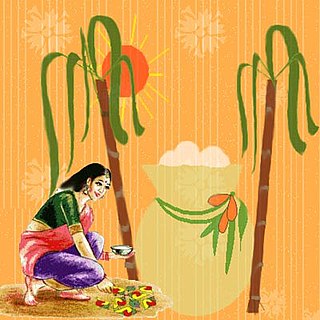
Pongal, is also referred to as Thai Pongal, is a multi-day Hindu harvest festival celebrated by Tamils in India and Sri Lanka. It is observed at the start of the month Tai according to Tamil solar calendar, and this is typically about January 14. It is dedicated to the Hindu sun god, the Surya, and corresponds to Makar Sankranti, the harvest festival under many regional names celebrated throughout India. The three days of the Pongal festival are called Bhogi Pongal, Surya Pongal and Maattu Pongal. Some Tamils celebrate a fourth day of Pongal as Kaanum Pongal.

The Wancho are indigenous people inhabiting the Patkai hills of Longding district in the Indian state of Arunachal Pradesh. Culturally Naga, they are ethnically related to the Nocte of Arunachal Pradesh and Konyak of Nagaland. The Wancho language belongs to the Tibeto-Burman family under Northern Naga languages
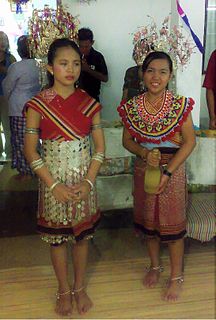
Gawai Dayak is an annual festival celebrated by the Dayak people in Sarawak, Malaysia and West Kalimantan, Indonesia on 1 and 2 June. It is a public holiday in Sarawak and is both a religious and a social occasion recognised since 1957.
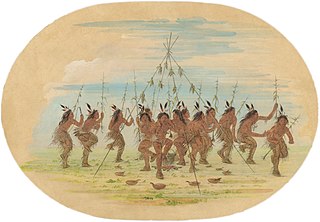
The Green Corn Ceremony (Busk) is an annual ceremony practiced among various Native American peoples associated with the beginning of the yearly corn harvest. Busk is a term given to the ceremony by white traders, the word being a corruption of the Creek word puskita (pusketv) for "a fast". These ceremonies have been documented ethnographically throughout the North American Eastern Woodlands and Southeastern tribes. Historically, it involved a first fruits rite in which the community would sacrifice the first of the green corn to ensure the rest of the crop would be successful. These Green Corn festivals were practiced widely throughout southern North America by many tribes evidenced in the Mississippian people and throughout the Mississippian Ideological Interaction Sphere. Green Corn festivals are still held today by many different Southeastern Woodland tribes. The Green Corn Ceremony typically occurs in late July–August, determined locally by the ripening of the corn crops. The ceremony is marked with dancing, feasting, fasting and religious observations.

The Dimasa people are an ethnolinguistic community presently inhabiting Assam and Nagaland states in Northeastern India. They speak Dimasa, a Tibeto-Burman language. This community is fairly homogeneous and exclusive, with members required to draw from both parents' separate clans. Dimasa kingdom, one of many early states in Assam following the downfall of Kamarupa kingdom, was established by these people. The Dimasas were till recently agricultural, centering on shifting agriculture; but in recent times this has changed with profound changes in the community. Following political problems in the 18th century, the Dimasa ruler moved further south in the plains of Cachar and there took place a division among them–with the hills Dimasa maintaining their traditional living and political exclusiveness, the plains Dimasas have made no attempt to assert themselves.
Moatsü is a festival celebrated by the Ao people of Nagaland, India. it is celebrated in the first week of May every year. Various rituals are performed during this period. The Aos observe Moatsü Mong after the sowing is done. The festival provides them a period of recreation and entertainment after the stressful work of clearing fields, burning jungles, sowing seeds, cleaning up the Tsubu (wells) and repairs and construction of houses by elders of the Putu Menden, stretching over a week. The Moatsü festival is marked by peppy songs and dances. The whole festival full of merrymaking and fun is observed only for three days from May 1 to 3.
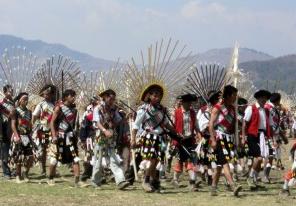
The Poumai Naga are one of the major Naga tribes in northeastern state of Manipur in India. The Poumai predominantly live in the Senapati District of Manipur, though there are villages in Nagaland state and one in ukhrul district. The Poumai mainly live in 100 villages that have been broadly divided into three blocks: Paomata, Lepaona and Chilivai. The Poumai speak their own language, Poula, and are generally Christians.

Magh Bihu (also called Bhogali Bihu or Maghar Domahi is a harvest festival celebrated in Assam, North-East India, which marks the end of harvesting season in the month of Magh. A bonfire is lit for the ceremonial conclusion and prayer to the God of Fire. The festival is developed by the Tibeto-Burman and Indo-aryan cultures and festivals Magan of Kachari.
Maram tribe is one of the tribes that form the Naga tribe of Northeast India. The Marams occupy a large portion of Senapati district of Manipur. They are the only tribe of Nagas who did not consume pork in the past; today, with the advent of Christianity, they have started changing their food habit and now almost 99% of the Marams consume pork. The Marams are known for their rich cultural heritage: traditional attire, folk songs, folktales, musical instruments, and so on. There are more than 30 Maram villages scattered in the geographical expanse generally known as the Maram Area. As per the 2001 census, the Maram Nagas numbered about 37,340 in total. According to UNESCO database on endangered languages, the Maram Language was among the list which amounts to only 37,000 number of speakers. These figures, however, need further corroboration.

The Lotha Nagas are a major Naga ethnic group native to Wokha District in the Indian state of Nagaland.
Tokhü Emong is a village festival celebrated by the Lotha Nagas in Nagaland, India. The nine day Fall festival celebrates the end of the harvest season.
The 'Sümi Naga' are a major ethnic group in the Indian state of Nagaland. The Sümis mainly inhabit Zünheboto District, parts of Niuland District and Kiphire District although many have spread and are now living in a few more districts within Nagaland.

The Liangmai tribe inhabits Nagaland and Manipur states of Northeast India. Their villages are mostly spread across Peren district in Nagaland and Tamenglong, Senapati in Manipur. There are also few villages in Dimapur, Imphal East and Imphal West districts. The Liangmais are the main inhabitants and dominate in Tening town, sub-division of Peren district of Nagaland state, and Tamei town, sub-division of Tamenglong district of Manipur state.
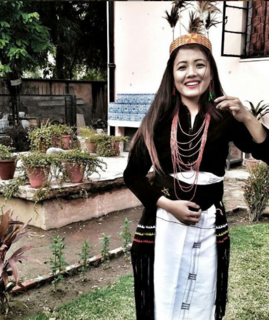
The Maring are one of the oldest tribe and ethnic group inhabiting Manipur State in North-East India. Their name is derived from mei meaning fire and ring meaning to start or produce. The people of Maring tribe are called Maringa. A mainly Christian people, they live chiefly in Tengnoupal district, Chandel and some places like Imphal, Senapati and so on.
Chang is a Naga tribe of Nagaland, India. It is one of the recognized Scheduled Tribes.
Phom is a Naga tribe from Nagaland, India. Their traditional territory lies between the territories of Konyak in the north-east, the Ao in the west and the Chang in the south. Yongnyah is the largest Phom village.
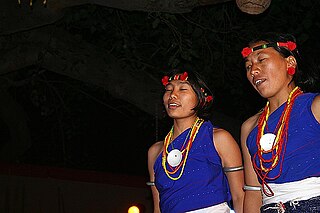
Pochury is a Naga tribe of Nagaland, India. The tribe's native territory is located in the eastern part of the Phek district, centered at Meluri town.
Jalukie is a town under Peren district of Nagaland State in India. Located in the Jalukie Circle, it is governed by a town committee.
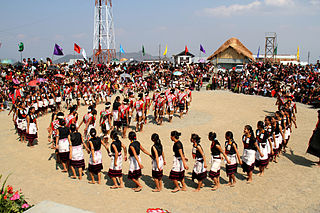
Sekrenyi, known locally as Phousanyi, is a major annual festival of the Angami Nagas, among the many festivals held by them, in the northeast Indian state of Nagaland. It is observed for ten days from the 25th day of the Angami calendar month of "Kezei" under the auspices of the Angami Public Organisation in association with many other organizations and the state government. It is a "purification festival" held to wash off all past sins. The objective of the festival is to renew and "make holy" by cleansing the "body and the soul" of the village as a whole, and to bring forth unity among all communities of Nagaland. It also marks initiation of young people to adulthood and is considered an "identity marker of the Angami". The Christian converts among the tribals have gradually rejected these rituals.












